OSTINATOS, 2007-2010
This series of work, consisting primarily of hand cut paper pieces mounted on the ends of dressmakers pins tacked into the wall, is a spin off of my previous series, One Hundred Drawings. Each piece documents a site of disaster re-photographed by me years after the event has occurred. Part requiem and part obsession, these pieces are a testament to those who have suffered there in the past. Each piece made in Ostinatos has a counterpart that exists as part of One Hundred Drawings and although both series are drawn from images of the same site, each piece has been generated from a different photograph and bears a different vantage point. Throughout my travels to each site, I have noticed many flowers. While cut flowers have been placed on the sites to mark a loss and secure a memory, others have grown on the sites simultaneously hiding and healing the scars of each disastrous event.
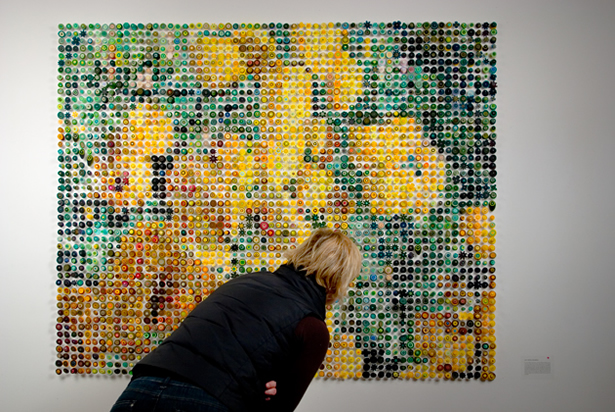
June 17, 1958 (for my grandfather)
(#1 from Ostinatos), 2007.
Paper, watercolor, casein, gouache, felt, beads and pins,
48 x 60 inches
Installed at Deluge Contemporary Art, Victoria, BC.
private collection
Event: On June 17, 1958, construction on the Second Narrows Bridge came to a halt when a large portion of its span collapsed into the inlet. Strapped to the bridge with harnesses, eighteen workers lost their lives. My grandfather was crab fishing in the inlet at the time and helped save some of the men that fell into the water. In the 1990's, the bridge was re-named the Ironworker’s Memorial Second Narrows Crossing as a tribute to the workers who lost their lives during its collapse. On both ends of the bridge are plaques commemorating the workers who died in the event. My piece depicts some small flowers located near the north end of the bridge.
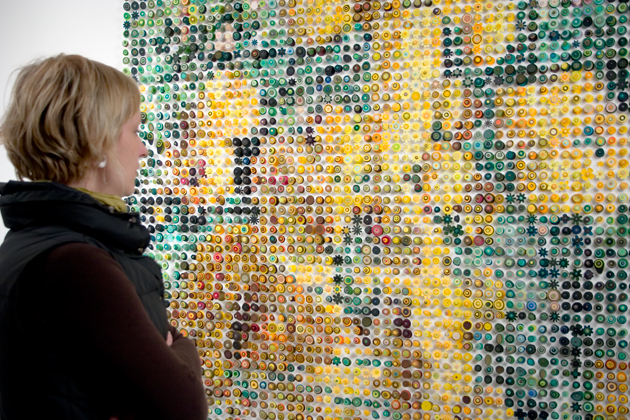
June 17, 1958 (for my grandfather) (#1 from Ostinatos), 2007
Paper, watercolor, casein, gouache, felt, beads and pins
48 x 60 inches
Installed at Deluge Contemporary Art, Victoria, BC
private collection
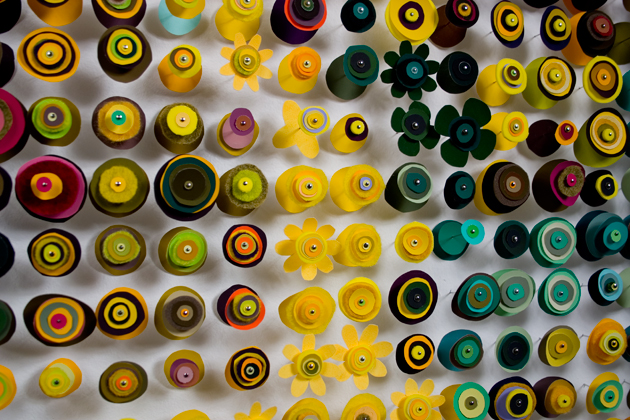
June 17, 1958 (for my grandfather) (#1 from Ostinatos), 2007
Paper, watercolor, casein, gouache, felt, beads and pins
48 x 60 inches
Installed at Deluge Contemporary Art, Victoria, BC
private collection

June 17, 1958 (for my grandfather)
(#1 from Ostinatos), 2007
Paper, watercolor, casein, gouache, felt, beads and pins
48 x 60 inches
Installed at Deluge Contemporary Art, Victoria, BC
private collection

June 17, 1958 (for my grandfather)
(#1 from Ostinatos), 2007
Paper, watercolor, casein, gouache, felt, beads and pins
48 x 60 inches
Installed at Deluge Contemporary Art, Victoria, BC
private collection
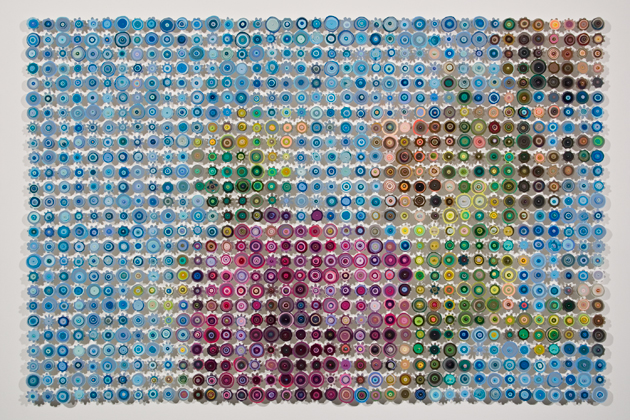
November 10, 1979 (#2 from Ostinatos), 2007
Paper, watercolor, casein, gouache, felt, beads and pins mounted on archival panel
26 x 39 inch image, 30 x 43 inch frame
private collection
At 11:53 pm on November 10, 1979, a train carrying styrene, toluene, propane, caustic soda, and chlorine derailed when passing through Mississauga, Ontario. An inadequately lubricated wheel bearing was the cause of the accident causing friction that ignited sparks and eventually got so hot that one pair of wheels fell off. The accident resulted in a huge explosion and fireball that reached 1,500 meters into the sky. A cloud of chlorine gas resulting from the accident caused the largest evacuation in peacetime history until Hurricane Katrina at more than 200,000 people. With the exception firefighters, who were exposed to the noxious fumes until the crisis was under control, there were no deaths from the accident. This work documents some flowering thistles at the site where the accident occurred.

November 10, 1979 (#2 from Ostinatos), 2007
Paper, watercolor, casein, gouache, felt, beads and pins mounted on archival panel
26 x 39 inch image, 30 x 43 inch frame
private collection
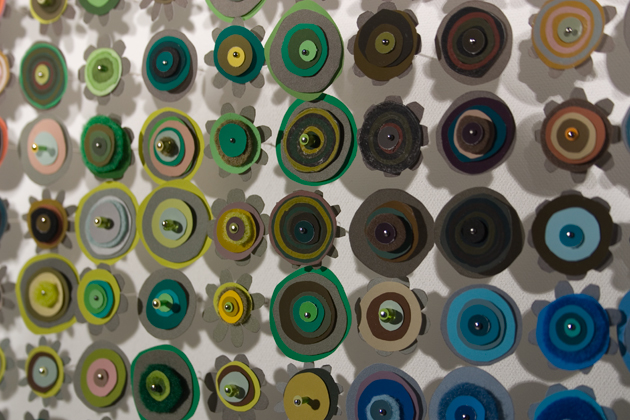
November 10, 1979 (#2 from Ostinatos), 2007
Paper, watercolor, casein, gouache, felt, beads and pins mounted on archival panel
26 x 39 inch image, 30 x 43 inch frame
private collection
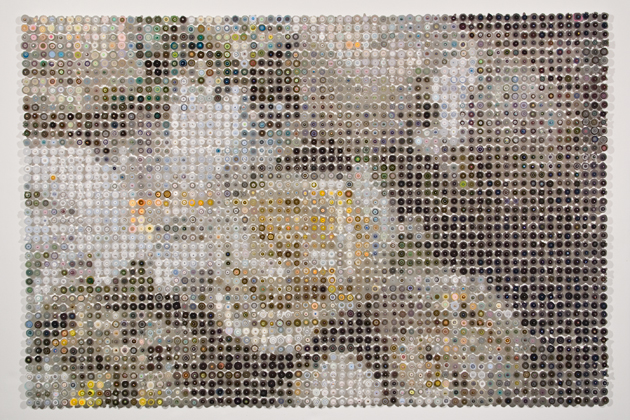
April 15, 1912 (#3 from Ostinatos), 2007
Paper, watercolor, casein, gouache, felt, beads and pins mounted on archival panel
30 x 45 inch image, 34 x 49 inch frame
private collection
This piece documents the flowers on gravesite holding Titanic victim 221, located in Fairview Cemetery in Halifax, NS. Three Canadian ships were involved in recovering the victims of the disaster. Of the 328 bodies recovered, Fairview cemetery holds the largest number of victims from this disaster. They are buried under unmarked graves identified only by numbers that refer to the order in which they were found.
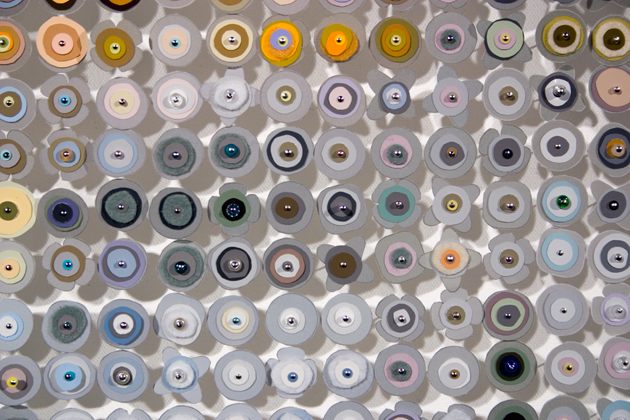
April 15, 1912 (#3 from Ostinatos), 2007
Paper, watercolor, casein, gouache, felt, beads and pins mounted on archival panel
30 x 45 inch image, 34 x 49 inch frame
private collection
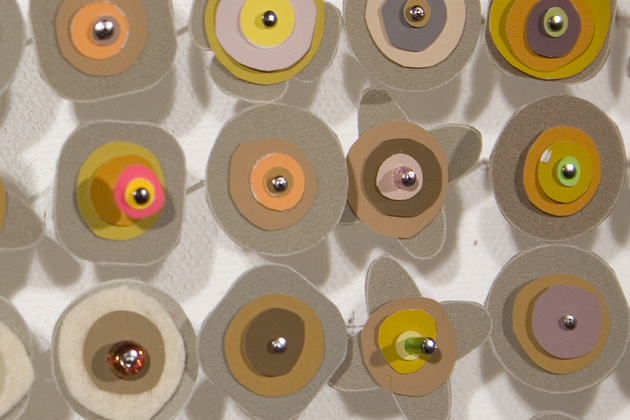
April 15, 1912 (#3 from Ostinatos), 2007
Paper, watercolor, casein, gouache, felt, beads and pins mounted on archival panel
30 x 45 inch image, 34 x 49 inch frame
private collection

September 17, 1949 (#4 from Ostinatos), 2008
Paper, gouache, felt, beads and pins mounted on archival panel
26 x 39 inch image, 30 x 43 inch frame
private collection
On the morning of September 17, 1949, a small fire was discovered in a locked linen closet aboard the passenger ship known as the S.S. Noronic. Once unlocked in an attempt to fight the flames with a single fire extinguisher, the fire raged out of control. It only took ten minutes for the fire spread rapidly throughout the interior of the ship because the woods in the ship were regularly treated with a lemon oil that was highly flammable. During the incident most passengers were sleeping and roused to a choking black smoke and packed corridors. Several of them escaped by jumping into the frigid waters of the Toronto Harbor. Most of the bodies were burned beyond recognition making identifying them difficult. This piece documents some day lilies on the pier where the accident occurred. Nearby there is a plaque commemorating those who perished.

September 17, 1949 (#4 from Ostinatos), 2008
Paper, gouache, felt, beads and pins mounted on archival panel
26 x 39 inch image, 30 x 43 inch frame
private collection

September 17, 1949 (#4 from Ostinatos), 2008
Paper, gouache, felt, beads and pins mounted on archival panel
26 x 39 inch image, 30 x 43 inch frame
private collection

September 17, 1949 (#4 from Ostinatos), 2008
Paper, gouache, felt, beads and pins mounted on archival panel
26 x 39 inch image, 30 x 43 inch frame
private collection
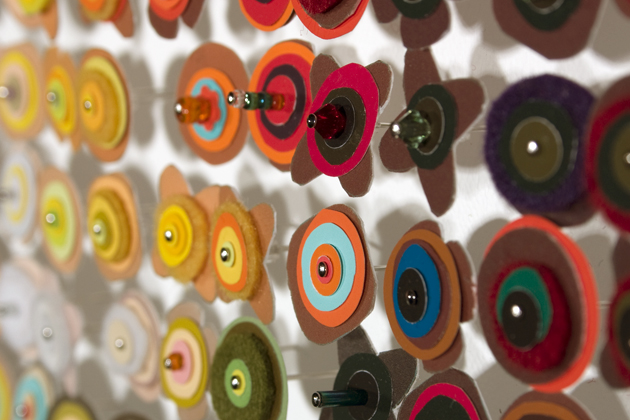
September 17, 1949 (#4 from Ostinatos), 2008
Paper, gouache, felt, beads and pins mounted on archival panel
26 x 39 inch image, 30 x 43 inch frame
private collection
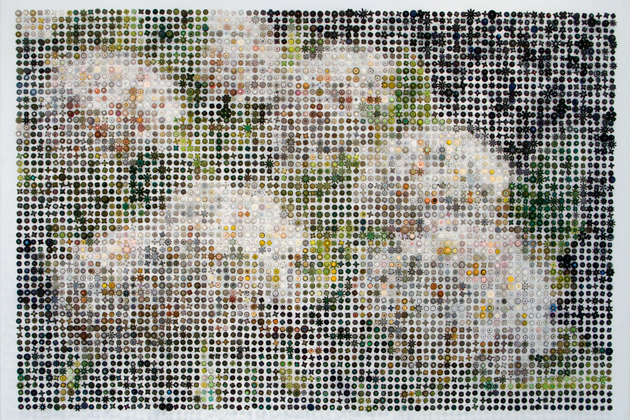
December 6, 1917 (#5 from Ostinatos), 2008
Color-Aid paper, 90 lb. Arches HP watercolor paper, Fabriano SP watercolor paper, Hahnemuhle photo ink jet paper, black sandpaper, silver paper, felt, screenprint, gouache, watercolor, sequins, Swarovski crystal beads, seed beads, dressmakers pins, hat pins
42 x 63 x 6 inches
private collection
At 9:04 on the morning of December 6, 1917, the Mont-Blanc, a French munitions ship inbound to Halifax, NS for a brief stop before heading off to the war in Europe collided with the outbound Imo, a Belgian reef ship. Due to the fact that the Mont-Blanc was carrying a load of gun cotton, TNT, and picric acid, the impact caused the ship to catch fire and blow up. The explosion had a devastating effect. It leveled much of northern Halifax and Dartmouth and caused 1,963 people to perish. Evidence of the disaster can still be found in Halifax including a broken window pane and a piece of wreckage that was driven into the wall from the blast. My piece documents some blooms on a tree above the site where the explosion took place.

December 6, 1917 (#5 from Ostinatos), 2008
Color-Aid paper, 90 lb. Arches HP watercolor paper, Fabriano SP watercolor paper, Hahnemuhle photo ink jet paper, black sandpaper, silver paper, felt, screenprint, gouache, watercolor, sequins, Swarovski crystal beads, seed beads, dressmakers pins, hat pins
42 x 63 x 6 inches
private collection
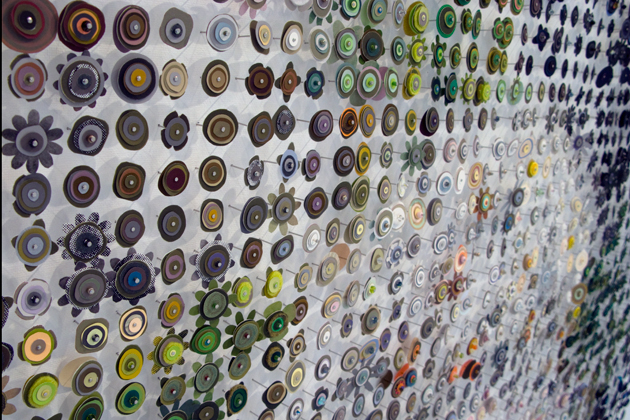
December 6, 1917 (#5 from Ostinatos), 2008
Color-Aid paper, 90 lb. Arches HP watercolor paper, Fabriano SP watercolor paper, Hahnemuhle photo ink jet paper, black sandpaper, silver paper, felt, screenprint, gouache, watercolor, sequins, Swarovski crystal beads, seed beads, dressmakers pins, hat pins
42 x 63 x 6 inches
private collection

December 6, 1917 (#5 from Ostinatos), 2008
Color-Aid paper, 90 lb. Arches HP watercolor paper, Fabriano SP watercolor paper, Hahnemuhle photo ink jet paper, black sandpaper, silver paper, felt, screenprint, gouache, watercolor, sequins, Swarovski crystal beads, seed beads, dressmakers pins, hat pins
42 x 63 x 6 inches
private collection

December 6, 1917 (#5 from Ostinatos), 2008
Color-Aid paper, 90 lb. Arches HP watercolor paper, Fabriano SP watercolor paper, Hahnemuhle photo ink jet paper, black sandpaper, silver paper, felt, screenprint, gouache, watercolor, sequins, Swarovski crystal beads, seed beads, dressmakers pins, hat pins
42 x 63 x 6 inches
private collection
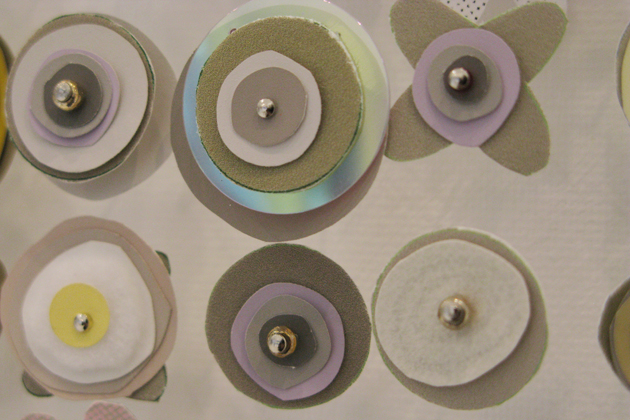
December 6, 1917 (#5 from Ostinatos), 2008
Color-Aid paper, 90 lb. Arches HP watercolor paper, Fabriano SP watercolor paper, Hahnemuhle photo ink jet paper, black sandpaper, silver paper, felt, screenprint, gouache, watercolor, sequins, Swarovski crystal beads, seed beads, dressmakers pins, hat pins
42 x 63 x 6 inches
private collection
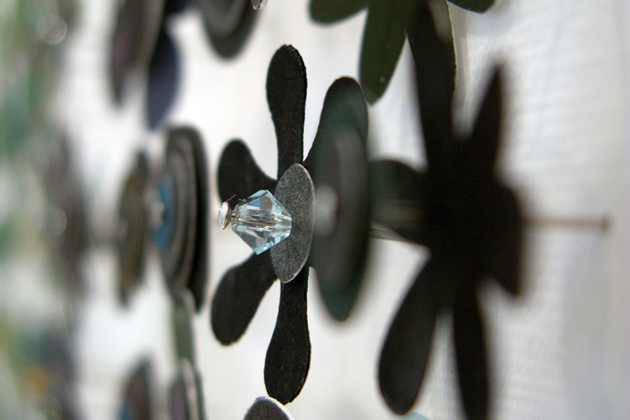
December 6, 1917 (#5 from Ostinatos), 2008
Color-Aid paper, 90 lb. Arches HP watercolor paper, Fabriano SP watercolor paper, Hahnemuhle photo ink jet paper, black sandpaper, silver paper, felt, screenprint, gouache, watercolor, sequins, Swarovski crystal beads, seed beads, dressmakers pins, hat pins
42 x 63 x 6 inches
private collection
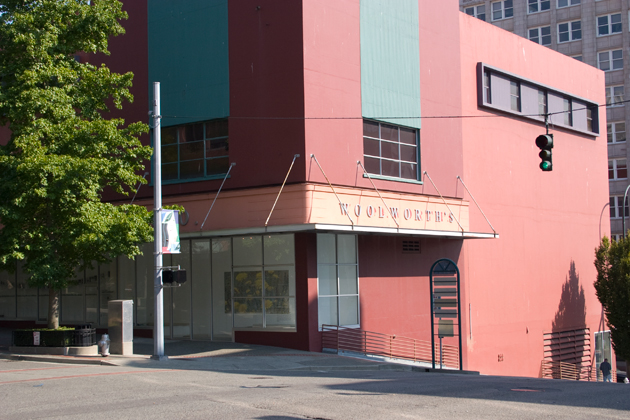
November 7, 1940 (for Tubby) (#6 from Ostinatos), 2008
Color-Aid paper, 90 lb. Arches HP watercolor paper, Fabriano SP watercolor paper, Hahnemuhle photo ink jet paper, felt, gouache, watercolor, sequins, beads, dressmakers pins
144 x 72 inches
On the morning of November 7, 1940, only four months after it opened to the public, the first Tacoma Narrows Bridge dramatically collapsed. Although no human lives were lost, a dog perished after it was abandoned in a car. The bridge, nicknamed “Galloping Gertie” for its wild undulating motion, attracted many visitors who would drive for miles to ride its swaying roadway. On windy days, cars were reported to vanish and reappear several times during a single crossing. This piece documents some dandelions growing near the site of the collapse.

November 7, 1940 (for Tubby) (#6 from Ostinatos), 2008
Color-Aid paper, 90 lb. Arches HP watercolor paper, Fabriano SP watercolor paper, Hahnemuhle photo ink jet paper, felt, gouache, watercolor, sequins, beads, dressmakers pins
144 x 72 inches
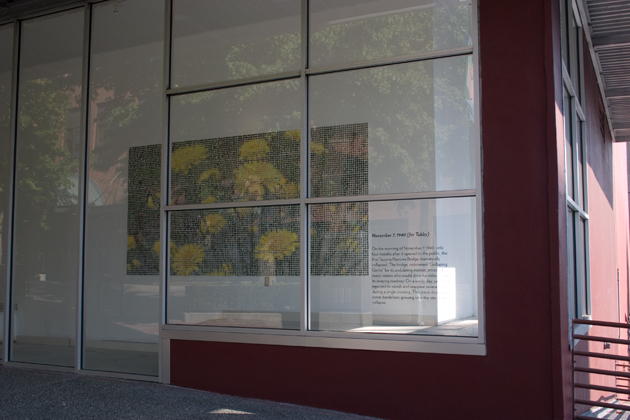
November 7, 1940 (for Tubby) (#6 from Ostinatos), 2008
Color-Aid paper, 90 lb. Arches HP watercolor paper, Fabriano SP watercolor paper, Hahnemuhle photo ink jet paper, felt, gouache, watercolor, sequins, beads, dressmakers pins
144 x 72 inches
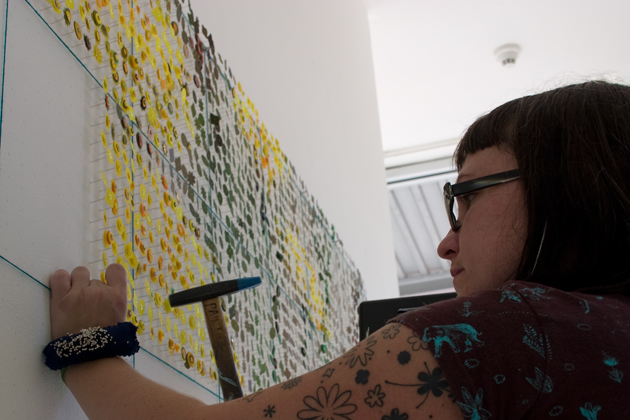
November 7, 1940 (for Tubby) (#6 from Ostinatos), 2008
Color-Aid paper, 90 lb. Arches HP watercolor paper, Fabriano SP watercolor paper, Hahnemuhle photo ink jet paper, felt, gouache, watercolor, sequins, beads, dressmakers pins
144 x 72 inches

November 7, 1940 (for Tubby) (#6 from Ostinatos), 2008
Color-Aid paper, 90 lb. Arches HP watercolor paper, Fabriano SP watercolor paper, Hahnemuhle photo ink jet paper, felt, gouache, watercolor, sequins, beads, dressmakers pins
144 x 72 inches

November 7, 1940 (for Tubby) (#6 from Ostinatos), 2008
Color-Aid paper, 90 lb. Arches HP watercolor paper, Fabriano SP watercolor paper, Hahnemuhle photo ink jet paper, felt, gouache, watercolor, sequins, beads, dressmakers pins
144 x 72 inches


November 7, 1940 (for Tubby) (#6 from Ostinatos), 2008
Color-Aid paper, 90 lb. Arches HP watercolor paper, Fabriano SP watercolor paper, Hahnemuhle photo ink jet paper, felt, gouache, watercolor, sequins, beads, dressmakers pins
144 x 72 inches

November 7, 1940 (for Tubby) (#6 from Ostinatos), 2008
Color-Aid paper, 90 lb. Arches HP watercolor paper, Fabriano SP watercolor paper, Hahnemuhle photo ink jet paper, felt, gouache, watercolor, sequins, beads, dressmakers pins
144 x 72 inches

November 7, 1940 (for Tubby) (#6 from Ostinatos), 2008
Color-Aid paper, 90 lb. Arches HP watercolor paper, Fabriano SP watercolor paper, Hahnemuhle photo ink jet paper, felt, gouache, watercolor, sequins, beads, dressmakers pins
144 x 72 inches
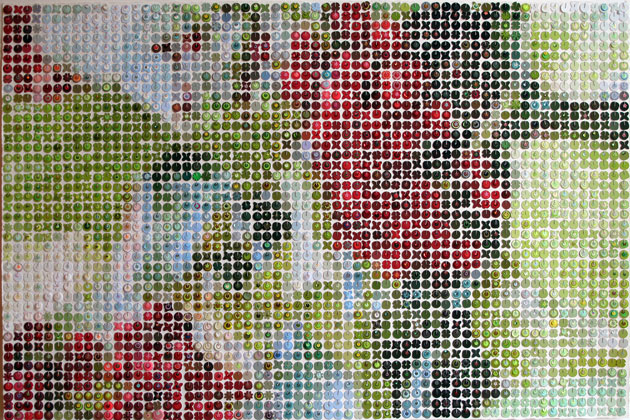
May 3, 1887 (#7 from Ostinatos), 2008
156 lb. Arches CP watercolor paper, Color-Aid paper, 90 lb. Arches HP watercolor paper, Hahnemuhle photo ink jet paper, felt, gouache, sequins, and thread
28 x 42 inches
Shortly before 6 pm on May 3, 1887, two explosions rocked the No. 1 Esplanade Mine, located just north of downtown Nanaimo, BC. The resulting fire and the carbon monoxide it produced resulted in the deaths of 147 miners and one rescuer. Near the entrance to the site is a memorial plaque listing the names of the miners that died in the accident. Of the dead listed are 53 Chinese immigrant workers known to the employers only by the numbers that were assigned to them. This piece depicts a tree with red berries located near this memorial plaque.

May 3, 1887 (#7 from Ostinatos), 2008
156 lb. Arches CP watercolor paper, Color-Aid paper, 90 lb. Arches HP watercolor paper, Hahnemuhle photo ink jet paper, felt, gouache, sequins, and thread
28 x 42 inches

May 3, 1887 (#7 from Ostinatos), 2008
156 lb. Arches CP watercolor paper, Color-Aid paper, 90 lb. Arches HP watercolor paper, Hahnemuhle photo ink jet paper, felt, gouache, sequins, and thread
28 x 42 inches
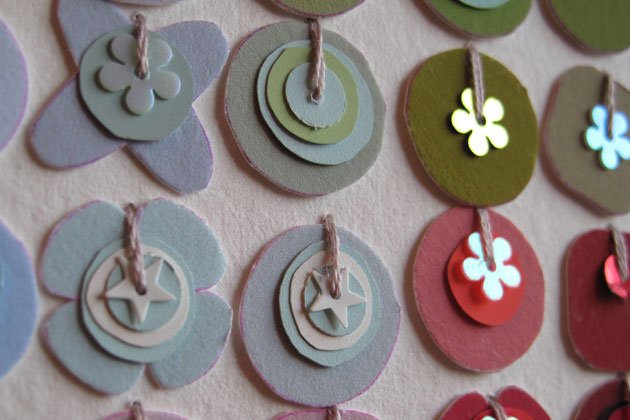
May 3, 1887
(#7 from Ostinatos), 2008
156 lb. Arches CP watercolor paper, Color-Aid paper, 90 lb. Arches HP watercolor paper, Hahnemuhle photo ink jet paper, felt, gouache, sequins, and thread
28 x 42 inches

April 5, 1958
(#8 from Ostinatos), 2010
Paper, watercolor, gouache, screenprint, felt, sequins, beads and pins mounted on archival panel
28 x 42 x 2 inches
Ripple Rock was a twin peaked underwater mountain located near the town of Campbell River, BC. Nearly twenty large vessels and about one hundred smaller ones fell victim to this treacherous rock before it was destroyed in 1958 by a planned explosion. The explosion created a column of debris that rose nearly 300 meters in height. It was considered a national historic event and was broadcast live on CBC Television. This piece documents some thistles growing on the side of the highway near the plaque that commemorates the event.On the evening of February 3, 1999, a large freighter was caught in a severe squall near Coos Bay. Unable to enter, the ship was forced to anchor for the night. Early the next morning, the anchor began to drag, and the ship broke apart on a remote sandy beach three miles north of port. Although the ship was empty of cargo, it was seeping oil from the roughly 400,000 gallons left in its fuel tanks. To avoid a larger spill, the remaining oil in the ship was intentionally burned off. Clouds of sticky black smoke rose from the hull of the ship. More than 3,000 shorebirds were killed. This piece documents some broom growing near the beach where the stern of the ship remains.

April 5, 1958 (#8 from Ostinatos), 2010
Paper, watercolor, gouache, screenprint, felt, sequins, beads and pins mounted on archival panel, 28 x 42 x 2 inches
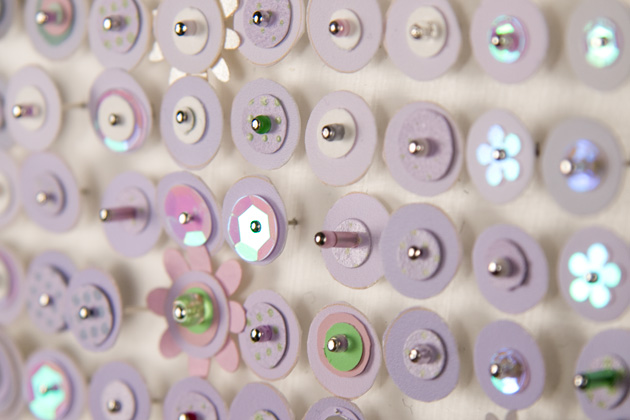
April 5, 1958 (#8 from Ostinatos), 2010
Paper, watercolor, gouache, screenprint, felt, sequins, beads and pins mounted on archival panel, 28 x 42 x 2 inches
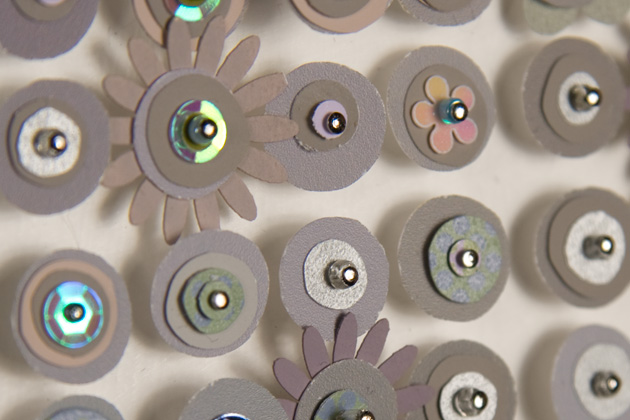
April 5, 1958 (#8 from Ostinatos), 2010
Paper, watercolor, gouache, screenprint, felt, sequins, beads and pins mounted on archival panel, 28 x 42 x 2 inches
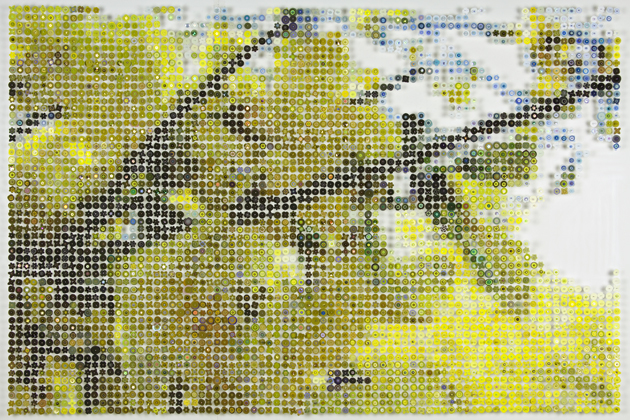
;On the evening of February 3, 1999, a large freighter was caught in a severe squall near Coos Bay. Unable to enter, the ship was forced to anchor for the night. Early the next morning, the anchor began to drag, and the ship broke apart on a remote sandy beach three miles north of port. Although the ship was empty of cargo, it was seeping oil from the roughly 400,000 gallons left in its fuel tanks. To avoid a larger spill, the remaining oil in the ship was intentionally burned off. Clouds of sticky black smoke rose from the hull of the ship. More than 3,000 shorebirds were killed. This piece documents some broom growing near the beach where the stern of the ship remains.
April 5, 1958
(#8 from Ostinatos), 2010
Paper, watercolor, gouache, screenprint, felt, sequins, beads and pins mounted on archival panel
28 x 42 x 2 inches
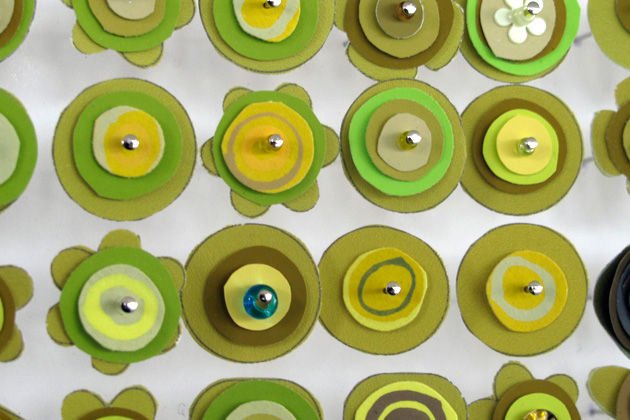
April 5, 1958
(#8 from Ostinatos), 2010
Paper, watercolor, gouache, screenprint, felt, sequins, beads and pins mounted on archival panel
28 x 42 x 2 inches